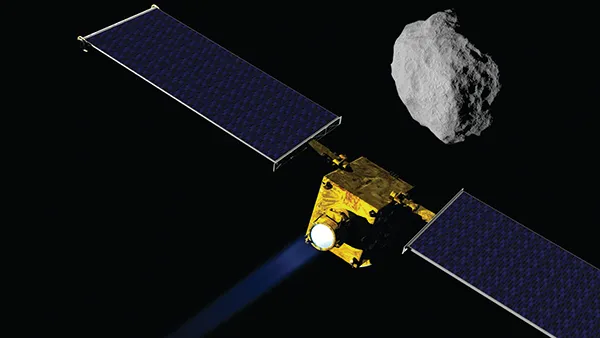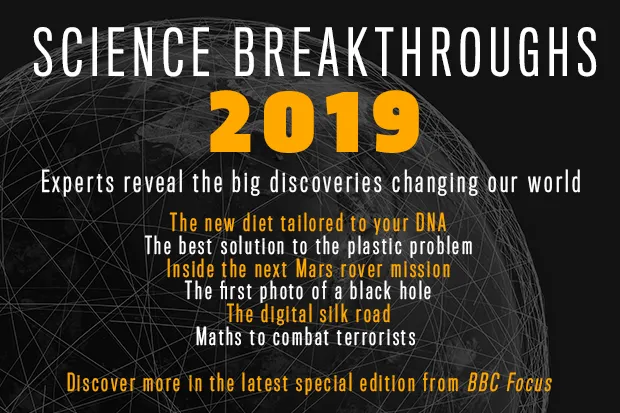News flash: We’ve found an asteroid bigger than the one that killed the dinosaurs and it’s heading straight for us! Thankfully, this scenario is yet to play out beyond films and TV. But the threat of an asteroid impacting Earth is very real.
Around 66 million years ago, an asteroid impact blasted enough soot into the atmosphere to cause extreme global cooling, wiping out 75 per cent of all life on Earth, including the dinosaurs. It’s only a matter of time before another huge space rock is destined for a high-speed date with our planet.
But a giant meteor flying straight towards Earth might not be as fatal as it was 66 million years ago. As science fiction author Larry Niven once said, “The dinosaurs are extinct because they didn’t have a space programme.” We do.
The world’s space agencies are finally rising to the challenge to protect humanity from the fate of our Cretaceous ancestors by mounting a mission that could give us the skills we need to change the course of a killer space rock – the Asteroid Intercept and Deflection Assessment (AIDA), the first ever attempt to change the course of an asteroid.
The mission starts in 2021, when NASA launches the Double Asteroid Redirection Test (DART), a spacecraft with a seemingly simple task in mind.
Read more 2019 science breakthroughs:
“We’re going to take a spacecraft which is around 100kg in mass and ram it into the moon of an asteroid,” says Andy Rivkin of the Johns Hopkins University. “Then we’re going to see what the effect of our ramming it is.”
The orbit of asteroid Didymos brings it within a mere 10 million km of Earth. In space terms, that’s right next door. DART’s actual target is the 170km space rock in orbit around it, nicknamed ‘Didymoon’. And by target, NASA means just that. DART will take aim, and smash directly into the moon. “We’re going straight in,” says Rivkin. “There’s no orbit. We get one shot.”
This high-speed crash should speed up Didymoon’s velocity by a few millimetres per second. It’s a tiny amount, but it is enough to change the moon’s orbit. With enough time, a similar technique – known as ‘kinetic impactor’ – could one day be used to change the path of an Earth-threatening asteroid so that it dodges past our planet.
After DART’s crash, NASA will watch Didymoon to see if the time it takes to orbit (currently 11.9 hours) gets any shorter. Seeing this change will not only tell the researchers that the mission was successful, but how successful it was. It is one thing to be able to change an asteroid’s orbit, it’s another to be able to predict how much it will change by.
It is this predictive ability that the second stage of the mission will look into. Just before impact, DART will launch a cubesat made by the Italian Space Agency. The cereal box-sized spacecraft, nicknamed ‘SelfiSat’, will watch the impact, taking pictures of the crash site to help geologists understand exactly what effect DART has had on the moon.
We won’t get a detailed view of what happened, though, until 2026 when the European Space Agency’s Hera spacecraft enters into orbit around Didymos and gets to know both main asteroid and moon in incredible detail.
“We need to get a precise measurement of the mass of this little moon”
Ian Carnelli, manager of the Hera mission
Knowing the mass is vital as it tells us exactly how big of a speed change we would expect to see from DART’s crash landing. But it will take more than that to fully understand the DART impact. “We’ll get a measure of the surface roughness, whether there are boulders on the surface, whether the interior structure has some voids. Because all of these affect the deflection,” says Carnelli.
This is vital to fine-tune the forecasting software researchers would use should we ever need to mount a real mission against an extinction level impact. By the end of AIDA we should not only know whether it is possible for us to deflect an asteroid, but be able to predict where we would be sending it.
“Asteroids are the only natural threat that we can predict, but also prevent,” says Carnelli. “When kinetic impactor is validated, then we really retire the risk of an asteroid impacting the Earth.” It has taken 66 million years, but planet Earth is finally ready to take out an insurance policy against the threat of killer asteroids.

How to save Earth
To dodge an asteroid, follow these three easy steps...
1
Search
We can’t deflect an asteroid unless we know it’s coming. Telescope surveys already scan the sky searching for potentially hazardous space rocks, and we think we know the location of over 90 per cent of extinction level asteroids, but one even a few dozen metres across could cause serious damage.
2
Characterisation
Once we know an asteroid is coming, we need to know what it’s like. Size, shape, composition and density all have an effect on how dangerous an asteroid is, but also how we can deal with it.
3
Mitigation
If we know about an asteroid a decade in advance, we can give it a gentle nudge using a similar technique to the DART mission. Over several years, a small change in course would be enough to avoid the Earth. However, if we don’t get enough warning, more drastic measures may have to be taken, such as using a nuclear bomb’s shockwave. A heavy asteroid would take more mass to stop, while a low density one might break apart.
Watch episodes of The Sky at Night bbc.in/2OcT67G

Follow Science Focus onTwitter,Facebook, Instagramand Flipboard

